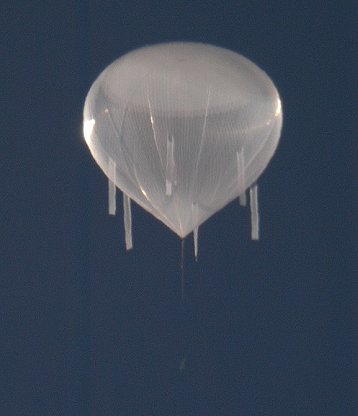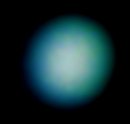QUIET WEEKEND: Solar activity is low and should remain so this weekend. Bright auroras are unlikely.
 Never miss another meteor shower. Or lunar eclipse. Or space station flyby. Sign up for Spaceweather PHONE.
Never miss another meteor shower. Or lunar eclipse. Or space station flyby. Sign up for Spaceweather PHONE.
NOT A UFO: Sometimes NASA scientists don't need to go all the way to space to do their experiments; the upper reaches of Earth's atmosphere is good enough. That's why NASA runs an active program of scientific ballooning.
On Sept. 16th, a NASA balloon took off from Fort Sumner, New Mexico, bound for the stratosphere. Harald Edens of nearby Socorro took this picture of it floating by at an altitude of 126,000 ft:

Details: Nikon D100 camera, 8" telescope, 1/750 sec, 400 ISO.
"It looked quite eerie after sunset, still being in full sunlight in a dark sky next to the crescent moon," says Edens. "The balloon was about as bright as Venus but it appeared bigger, likely making some people think they were seeing a UFO."
This balloon is still in the air. Becky Ramotowski saw it near Tijeras, New Mexico, on Sept. 16th (picture) and Victor Bobbett spotted it over Phoenix, Arizona, on Sept 17th (picture).
 URANUS: Earth and Uranus are having a close encounter this month; the two worlds are "only" 2.9 billion km apart. Shining like a 6th magnitude star, Uranus is barely visible to the unaided eye. Look for it in the constellation Aquarius around 10 o'clock at night, but don't bother unless you have very dark skies. [sky map]
URANUS: Earth and Uranus are having a close encounter this month; the two worlds are "only" 2.9 billion km apart. Shining like a 6th magnitude star, Uranus is barely visible to the unaided eye. Look for it in the constellation Aquarius around 10 o'clock at night, but don't bother unless you have very dark skies. [sky map]
Better yet, use a telescope. Ralf Vandebergh of the Netherlands took the above picture of Uranus on Sept. 16th using a 10-inch telescope and a digital web camera.
"Uranus has a strong polar flattening due to its fast rotation (17 hours and 14 minutes)," says Vandebergh. "This image clearly shows the flattening. It was also observable by eye--simply looking through the telescope's eyepiece--at 300x in excellent seeing."

